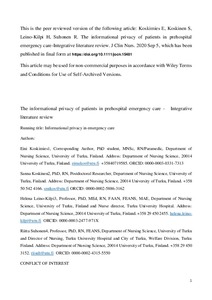The informational privacy of patients in prehospital emergency care - Integrative literature review
Koskimies Eini; Koskinen Sanna; Leino-Kilpi Helena; Suhonen Riitta
https://urn.fi/URN:NBN:fi-fe2021042824530
Tiivistelmä
Background: Informational privacy, a central value in health care, is strongly connected to patients' safety and quality of care. However, its realisation faces challenges in the unique context of prehospital emergency care.
Design: Integrative literature review.
Methods: Systematic searches of the CINAHL, MEDLINE and Cochrane library databases (n = 1588) and a manual search of the reference lists of the included articles (n = 0) were conducted in August 2019. In the article selection, specified inclusion and exclusion criteria were used. Two Joanna Briggs Institute quality appraisal tools were used. Ultimately, 11 studies were included. Analysis was conducted by using content analysis. Overall, process of the review was guided by PRISMA checklist.
Results: The number of primary research studies related to informational privacy in prehospital emergency care is limited and mainly focused on privacy and confidentiality. The informational privacy was described from three aspects (a) information control by patients, (b) information protection by healthcare professional and (c) concepts related to informational privacy. The realisation of patients' informational privacy varied. Factors related to the realisation were related to the paramedics, the prehospital emergency care work and the patients.
Conclusion: More research specifically focused on informational privacy in prehospital emergency care is needed. Paramedics' understanding of informational privacy and its protection is essential to enhance the realisation of patients' informational privacy. Therefore, a response is required to their need for more education concerning informational privacy.
Relevance to clinical practice: Paramedics' attention should be drawn to the identified factors related to the realisation of informational privacy and its use in clinical practice in order to continue to provide high-quality prehospital emergency care.
Kokoelmat
- Rinnakkaistallenteet [27094]
